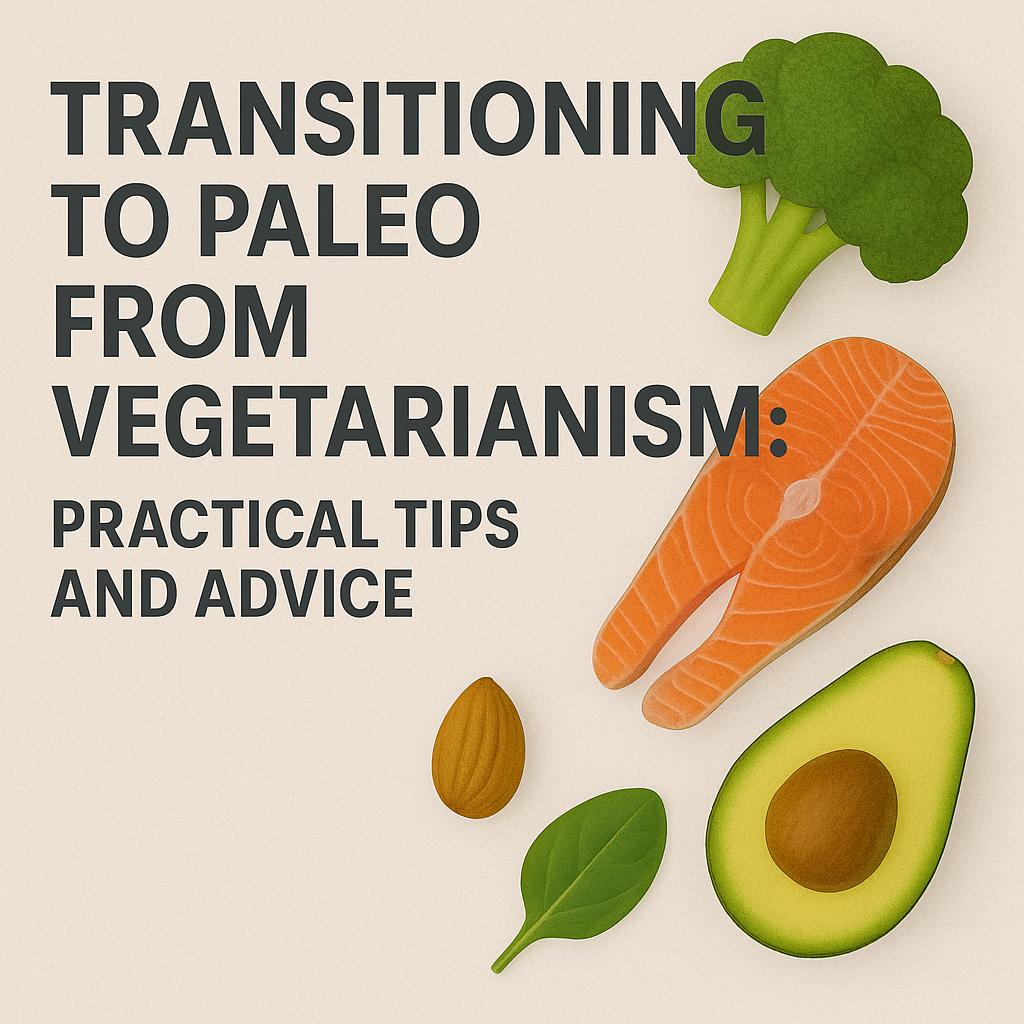Transitioning to Paleo from Vegetarianism: Practical Tips and Advice
Moving from vegetarian to Paleo can be a big shift—but with smart planning, you can do it in a nourishing, sustainable way (without getting overwhelmed).

🚦 Why Make the Switch?
Vegetarianism emphasizes plants, grains, and legumes. Paleo, by contrast, focuses on whole foods like meat, seafood, eggs, and healthy fats—while cutting out grains and legumes.
People often switch for reasons like:
- Improving digestion or reducing bloating
- Balancing hormones or blood sugar
- Enhancing energy and satiety
- Boosting nutrient intake, especially B12, iron, and EPA/DHA
If you’re curious about how these benefits compare, check out “Is the Paleo Diet Healthy?” for more context.
🧠 Step 1: Mindset Shift—Leave No Nutrient Behind
You don’t have to go full-throttle overnight. Start with one meal at a time.
- Add an egg or pasture-raised chicken to your breakfast—like scrambled with spinach.
- Swap grains for veggies at lunch—try a big salad with kale and olive oil.
- Use small amounts of 4th & Heart Grass-Fed Ghee or Chosen Foods Avocado Oil for cooking.
🍳 Step 2: Fill Protein Gaps Smartly
Vegetarians often rely on legumes and dairy. On Paleo, lean protein is essential.
Try these beginner-friendly options:
- Vital Farms Pasture-Raised Eggs – easy and versatile
- Wild Planet Wild-Caught Salmon – packed with omega-3s
- CHOMPS Grass-Fed Beef Sticks – perfect protein on-the-go
If you need a fast boost, supplement with clean protein powders like Ancient Nutrition Bone Broth Protein or Equip Prime Beef Isolate.
🥗 Step 3: Rebuild Your Plate
Vegetarian plates often include lots of grains, beans, and cheese. Paleo plates focus on:
- Protein (meat, fish, eggs)
- Veggies (greens, cruciferous, roots)
- Healthy fats (avocado, coconut, ghee)
Example meals:
- Egg + veggie scramble cooked in ghee
- Salmon bowl with roasted veggies and avocado oil
- Stir‑fry chicken with peppers and coconut oil
For cook-friendly tools, try our Essential Non-Toxic Cookware guide and invest in tools like a Lodge Cast Iron Skillet and Instant Pot Duo.
🧂 Step 4: Mindful Snacking
Leave behind cheese and granola. Instead, prep Paleo-friendly snacks:
- RXBAR Whole Food Bars
- Bare Baked Apple Chips
- Nut butters like Artisana Almond Butter
Vegetable sticks with ghee-based dips are also great. For more snack ideas, see 10 High‑Protein Paleo Snacks You Can Make in Under 15 Minutes.
💊 Step 5: Mind Gut Health & Digestion
Introducing more fat and meat can impact digestion. Support yourself with:
- Garden of Life Primal Defense Ultra Probiotic
- NOW Super Enzymes
- Sips of Kettle & Fire Bone Broth daily
This helps your gut adapt and reduces bloating over time.
📅 Step 6: Build Structure (Without Stress)
Change is easier with a plan. Try these strategies:
- Follow our 30-Day Paleo Meal Plan
- Meal prep with bulk tools like Instant Pot and store food in Prep Naturals Glass Containers
- Track how you feel—especially energy, digestion, and mood
⚠️ Step 7: Watch for Common Transition Errors
The most common slip-ups include:
- Loading up on meat, not enough veggies
- Swapping grains for snacks like nut butters or Paleo treats only
- Neglecting hydration and electrolytes
To stay on track, check out Common Mistakes in Paleo Dieting and keep snacks handy.
🧭 Final Thoughts
Transitioning from vegetarianism to Paleo is absolutely possible—and rewarding. By taking small steps and planning, you’ll nourish your body deeply and feel renewed energy and digestion support.
📌 Quick Start Checklist
- Add eggs, fish, or pasture meat gradually
- Swap grains for veggies and healthy fats
- Prep Paleo snacks ahead of time
- Use gut-support supplements
- Follow the 30‑Day Paleo Meal Plan
- Track energy, digestion, and mood
